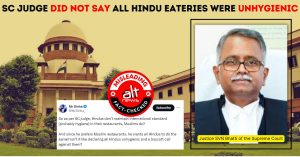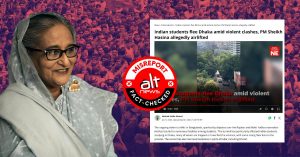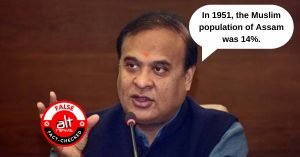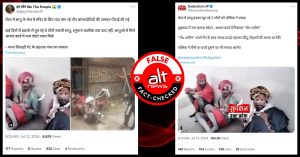On February 23, followers of Punjab’s pro-Khalistan leader Amritpal Singh clashed with the police outside Ajnala police station near Amritsar, Punjab, and demanded the release of one of the members of the outfit, Waris Punjab De, Lovepreet Singh, who had been arrested in an alleged case of ‘kidnapping, theft, and voluntarily causing hurt’.
The followers breached the barricades of the police station with guns and swords, visuals of which were displayed on television news across the nation. Later, on February 24, Lovepreet Singh walked out of Amritsar Central Jail after the local court ordered his release based on an application by the police, reported The Indian Express.
In this context, Amritpal Singh made several media appearances. On one such occasion, he told a Republic Bharat reporter, “There was no Bharat, there was no India before 1947… It’s a union of states, we must respect the unions, we must respect the states, otherwise you know, what we say if we don’t respect diversity, we will lose everything. So I do not agree with the definition of India…Modern India. All I am saying is everybody has the right to self-determine, if I say Punjab is a separate country, I have the right to do it…”
The viral bit started at the 40:31-minute mark.
Soon after this, several BJP leaders shared the video of Amritpal Singh making the comments alongside a clip of Rahul Gandhi saying, “You will find that India is described as a Union of States. India is not described as a nation, it is described as a Union of States.” The viral montage has a subsequent text at the bottom that reads, “Speaking same language.”
Filmmaker Ashoke Pandit shared the clip and wrote,”#RahulGandhi speaking the same language as that of a #Khalistani leader”
#RahulGandhi speaking the same language as that of a #Khalistani leader .
Congress has not learnt lessons even after loosing their leaders .
They created #Bhindranwale & #AAP creats #AmritpalSingh .
Will pray the price . pic.twitter.com/skxL8ma0EO— Ashoke Pandit (@ashokepandit) February 24, 2023
Assam chief minister and BJP leader Himanta Biswa Sarma also shared the clip on Twitter and wrote, “See who speaks the language of Rahul Gandhi!”
See who speaks the language of Rahul Gandhi!
Amritpal Singh, who stormed a police station in Amritsar in a brazen act of defiance, is imitating his words.
Congress, its leaders & all those who use divisive language to disintegrate the sanctity of ‘Akhand Bharat’ must apologise! pic.twitter.com/jDefg2EE6a
— Himanta Biswa Sarma (@himantabiswa) February 24, 2023
Right Wing media personality Major Surendra Poonia, too, shared the clip on Twitter.
Same to Same ! pic.twitter.com/uWROd0DkoW
— Major Surendra Poonia (@MajorPoonia) February 24, 2023
Fact Check
We found that the clip of Rahul Gandhi in circulation is from February 2022. The Congress leader in a 40-minute-long address in the Parliament spoke about the importance of cooperative federalism. He referred to the fact that in the Constitution, India is described as a union of states.
“If you read the Constitution of India, you will find it, and many of my colleagues who have not read it should look at it. You will find that India is described as a union of states, India is not described as a nation, it is described as a union of states. What does that mean? That means my brother from Tamil Nadu has to have the same rights as my brothers.. my sister from Maharashtra as my brother from Uttar Pradesh as my brother from Bihar or my sister from Manipur, Nagaland, Mizoram, that’s what it means”.
At the 18.50-minute mark he says, “There are two visions of this country. One vision is that it is a union of states. Meaning, that it is a negotiation, meaning, it is a conversation. Meaning, I go to my brother in Tamil Nadu and I say, what do you want? And he says, this is what I want. And then he asks me, what do you want? And I say this is what I want. It is a partnership. It is not a kingdom.”
He adds, “…It has always been ruled by conversation and negotiation. Now, the problem is you people are confused. The problem is you people think that these languages, these cultures, these histories… you think that you can suppress them. You have no idea of history, you have no idea what you are dealing with. Because the people of Tamil Nadu have inside their hearts the idea of Tamil Nadu, the idea of the Tamil language and then also the idea of India. Do not be confused.”
“There is another vision, a vision that India can be ruled by a stick of the Centre. You people have no idea of history. Because every time that has been attempted, the stick has been broken and smashed. Now what is happening is that the result of your flawed vision of the country, two Indias are of course being created… So, there are two visions. One is a union of states, the union of languages, and union of cultures. A bouquet of beautiful flowers that can challenge any power in the world. No power in the world has been able to challenge this bouquet of flowers. Now there is a second vision, a centralizing vision, the vision of a king.” Rahul said.
Below we have added the full speech, the relevant portion begins at the 17:05-minute mark.
The contrast between what Rahul said and what Amritpal Singh said
There is a clear contrast between what Rahul Gandhi said and what Amriptal Singh said. When we break down Rahul Gandhi’s speech, we notice that he spoke about the plurality of India.
Here we have highlighted the relevant section.
“You will find that India is described as a union of states. India is not described as a nation, it is described as a union of states. What does that mean? That means my brother from Tamil Nadu has to have the same rights as my brothers.. my sister from Maharashtra as my brother from Uttar Pradesh as my brother from the Bihar or my sister from Manipur, Nagaland, Mizoram. That’s what it means.”
He also says, “… the people of Tamil Nadu have inside their hearts, the idea of Tamil Nadu, the idea of the Tamil language and then also the idea of India. Do not be confused.”
The words ‘also the idea of India‘ are crucial to the understanding of Rahul Gandhi’s thoughts.
When we compare this to Amritpal Singh’s speech, the distinction becomes clear.
Singh says, “It’s a union of states, we must respect the unions, we must respect the states, otherwise you know, what we say if we don’t respect diversity, we will lose everything. So I do not agree with the definition of India…Modern India. All I am saying is everybody has the right to self-determine, if I say Punjab is a separate country, I have the right to do it…”
The first part of his statement, just like Rahul Gandhi’s, talks about the diversity and plurality of India. However, the second part implies that a state can break away from the union because India is a union of states.
Below we have provided a table in which the similarity between Gandhi’s speech and Singh’s speech is highlighted in yellow and the distinction in green.
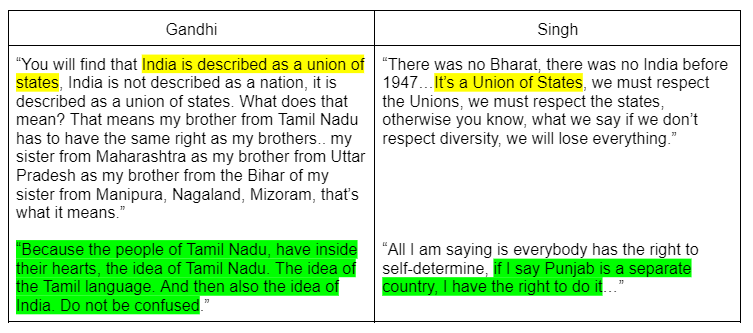
Significance of the phrase ‘union of states’
Article 1 of the Constitution says “India, that is Bharat, shall be a Union of States.” 
Alt News also spoke with senior advocate Sanjoy Ghose regarding the statement of Rahul Gandhi. He said, “First of all, the Constitution does not deal with the concept of ‘nation’. The core of the Constitution is not a ‘nation’, but individuals. This is why you have fundamental rights for the individual and then you have directive principles for the community.”
He added, “Nation comes in through the 42nd Amendment where the Fundamental Duties were added. Some issues of the nation, like one must respect the national flag etc., were added. By and large, Rahul Gandhi paraphrased the Article 1 of the Constitution. It says Indian that is Bharat ‘shall be a Union of States’ and not ‘India is a Union of States’. This means that the Constitution permits you to modify the states, unlike the US constitution, which does not allow the Federation to create new states or alter the borders of existing states.”
The Indian Constitution allows the alteration of states and it has been done in the past, for example; the making of Jharkhand from Bihar. However, the central government cannot decide that all states would become Union Territories and would be governed from the Centre. Therefore, it uses the word, ‘shall be a Union of States’, which means it will always be a union of states. So the emphasis here is that one has to respect the plurality, one has to respect the rights of states, and one has to see it as the coming together of states.”
Ghose’s explanation of Article 1 of the Constitution appears to be directly in line with what Rahul Gandhi said. Moreover, Ghose put emphasis on the fact that though the Centre has the power to change boundaries and create new states out of existing states, which has been done in the past, it does not mean that the Centre can do away with states. There cannot be a situation where states do not exist and all power rests with the Centre.
To understand the historical context, Alt News looked at the writings and speeches of Dr Ambedkar, the father of the Indian Constitution. A project by Ambedkar International Center (AIC) has made it possible to virtually access all of Dr Ambedkar’s writings. Here, we found that while addressing critics, Dr Ambedkar explained why Article 1 of the Draft Constitution described India as a union of states.
He said, “The Drafting Committee wanted to make it clear that though India was to be a Federation, the Federation was not the result of an agreement by the States to join in a Federation and that the Federation not being the result of an agreement no State has the right to secede from it.” Below we have added the relevant portion of his speech. Readers interested in reading the full text can do so by clicking on this link.

This text clearly states that the federation was not the result of an agreement by the states and hence no state has the right to secede.
Hence it is clear that there is distinction between what Rahul said and what Amritpal Singh said. Rahul’s words were in sync with the Constitution, but Singh’s were not.
On a related note, BJP leader and Karnataka chief minister Basavaraj Bommai, too, recently made the remark that “India is a Union of States. Every State has its own rights”.
“Our India is a Union of States. Every State has its own rights,” says @CMofKarnataka @BSBommai in response to SS- @BJP4Maharashtra coalition govt raking up border dispute.
Demands action against incidents of vandalism before they create divide between States. @TheSouthfirst pic.twitter.com/cr8G9cDy9e
— Anusha Ravi Sood (@anusharavi10) November 25, 2022
Independent journalism that speaks truth to power and is free of corporate and political control is possible only when people start contributing towards the same. Please consider donating towards this endeavour to fight fake news and misinformation.

